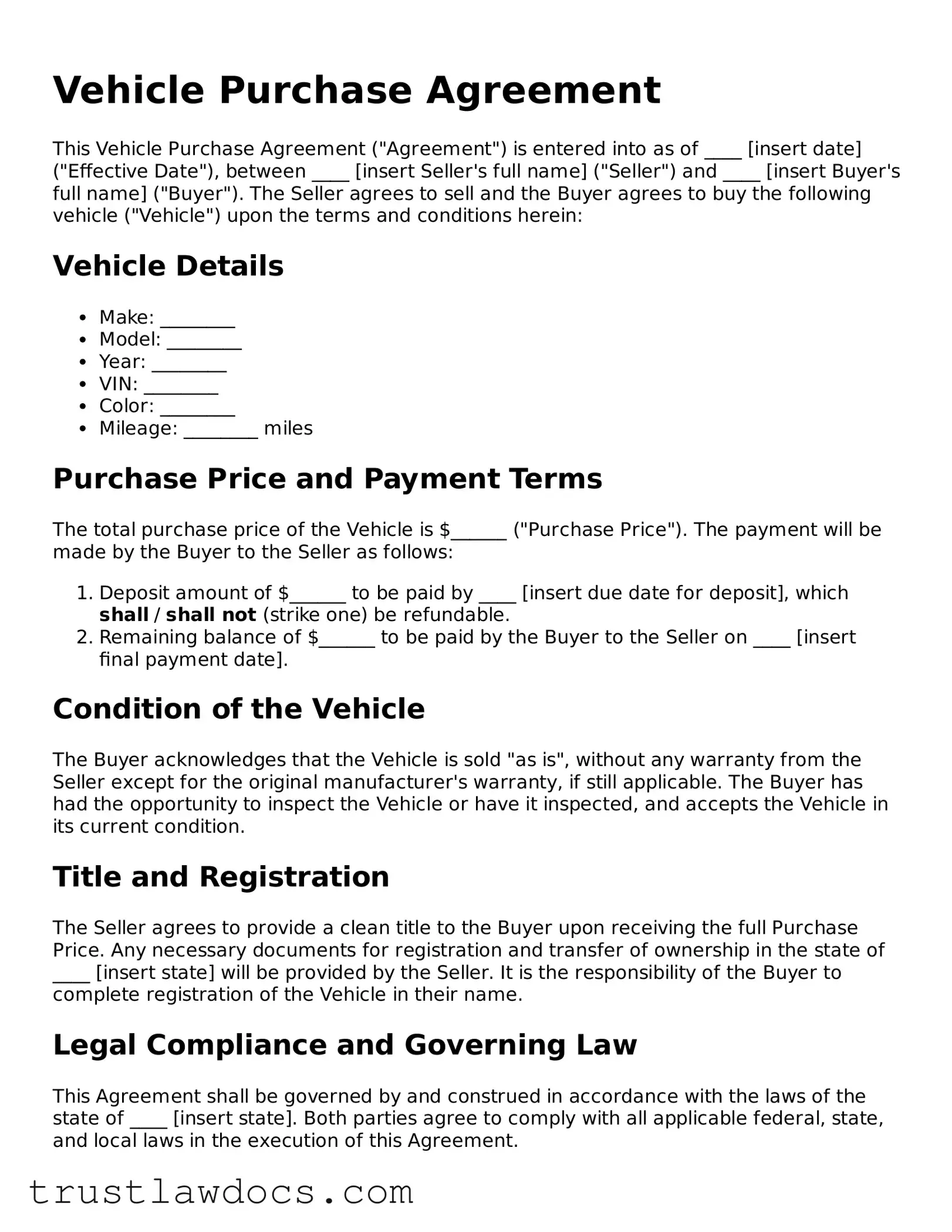What is a Vehicle Purchase Agreement?
A Vehicle Purchase Agreement is a legal document that outlines the terms and conditions of the sale of a vehicle between a buyer and a seller. This includes details such as the purchase price, information about the vehicle (make, model, year, VIN), and the warranties or guarantees provided. It serves as a binding contract that protects the rights of both parties involved.
Do I need a Vehicle Purchase Agreement to buy or sell a car privately?
Yes, it is highly recommended to use a Vehicle Purchase Agreement when buying or selling a car privately. This agreement provides a clear record of the sale, helps to avoid misunderstandings, and ensures that both parties are aware of their rights and obligations.
What details should be included in a Vehicle Purchase Agreement?
Key details to include in a Vehicle Purchase Agreement are the names and addresses of the buyer and seller, the purchase price, a detailed description of the vehicle (including make, model, year, and VIN), any warranties or guarantees, payment methods, and delivery date. It may also cover any conditions for the sale, inspection rights, and information on how disputes will be resolved.
Can I draft a Vehicle Purchase Agreement on my own?
While one can draft a Vehicle Purchase Agreement on their own, it is advisable to use a template or seek professional legal help to ensure that all necessary details are correctly included and the document is compliant with applicable laws. This helps in safeguarding the interests of both the buyer and seller.
How does a Vehicle Purchase Agreement protect the buyer?
The agreement protects the buyer by clearly stating the condition of the vehicle, specifying any warranties or guarantees, and ensuring that the vehicle is free from any outstanding liens or encumbrances. It also provides legal recourse if the seller fails to meet the terms outlined in the agreement.
How does a Vehicle Purchase Agreement protect the seller?
For the seller, the agreement outlines the obligation of the buyer to pay the agreed price by a certain date. It also limits the seller's liability once the vehicle is sold, assuming all the conditions described in the agreement are met, and provides evidence that the buyer has agreed to buy the vehicle "as is" or under the conditions specified.
Is a Vehicle Purchase Agreement legally binding?
Yes, when signed by both the buyer and seller, the Vehicle Purchase Agreement becomes a legally binding contract. It is enforceable in a court of law, should any disputes arise from the terms agreed upon by both parties.
What happens if either party breaches the Vehicle Purchase Agreement?
If either party breaches the agreement, the aggrieved party has the right to seek legal remedies. This could include suing for specific performance (to compel the breaching party to fulfill their part of the agreement) or for damages caused by the breach.
Can modifications be made to a Vehicle Purchase Agreement after it's signed?
Modifications to a Vehicle Purchase Agreement can be made after it’s signed, but any changes must be agreed upon by both the buyer and seller. It is best to document these changes in writing, and both parties should sign or initial any amendments to the original agreement to ensure these modifications are legally enforceable.
How long is a Vehicle Purchase Agreement valid?
The validity of a Vehicle Purchase Agreement lasts until the obligations outlined within the agreement are fulfilled by both parties. After the purchase price is paid in full, and the vehicle is delivered to the buyer, the contract is considered complete, and its terms are no longer enforceable unless warranties or guarantees extending beyond the date of sale are included.
